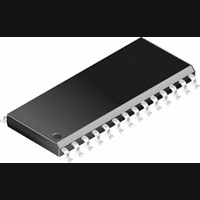CS8420-CS Cirrus Logic Inc, CS8420-CS Datasheet - Page 21

CS8420-CS
Manufacturer Part Number
CS8420-CS
Description
Transceiver IC
Manufacturer
Cirrus Logic Inc
Datasheet
1.CS8420-CS.pdf
(80 pages)
Specifications of CS8420-CS
Audio Control Type
Sample Rate Converter
Supply Voltage Range
4.75V To 5.25V
Operating Temperature Range
-10°C To +70°C
Audio Ic Case Style
SOIC
No. Of Pins
28
Msl
MSL 2 - 1 Year
Frequency Max
108GHz
Bandwidth
20kHz
Rohs Compliant
No
Lead Free Status / RoHS Status
Contains lead / RoHS non-compliant
Available stocks
Company
Part Number
Manufacturer
Quantity
Price
Company:
Part Number:
CS8420-CS
Manufacturer:
CRY
Quantity:
5 510
Company:
Part Number:
CS8420-CS
Manufacturer:
CIRRUS
Quantity:
225
Part Number:
CS8420-CS
Manufacturer:
CRYSTAL
Quantity:
20 000
Company:
Part Number:
CS8420-CS*
Manufacturer:
NEC
Quantity:
700
Company:
Part Number:
CS8420-CSZ
Manufacturer:
CIRRUS
Quantity:
319
Company:
Part Number:
CS8420-CSZ
Manufacturer:
CIRRUS
Quantity:
9 908
Part Number:
CS8420-CSZ
Manufacturer:
CIRRUS
Quantity:
20 000
8.
A special mode is available that allows the clock
that is being input through the OMCK pin to be out-
put through the RMCK pin. This feature is con-
trolled by the SWCLK bit in register 4 of the
control registers. When the PLL loses lock the fre-
quency of the VCO drops to 300 kHz. The SWCLK
function allows the clock from RMCK to be used
as a clock in the system without any disruption
when input is removed from the Receiver.
9.
The PLL behavior is affected by the external filter
component values. Figure 5 shows the configura-
tion of the required 2 capacitors and 1 resistor. Two
alternate sets of component values are recommend-
ed, depending on the requirements of the applica-
tion (see Table 1). The default set, called “fast”,
accommodates input sample rates of 16 kHz to
108 Hz with no component changes. It has the
highest corner frequency jitter attenuation curve,
and takes the shortest time to lock. The alternate
component set, called “medium” allows the lowest
input sample rate to be 8 kHz, and increases the
lock time of the PLL. Lock times are worst case for
an Fsi transition of 96 kHz.
9.1
While decoding the incoming AES3 data stream,
the CS8420 can identify several kinds of error, in-
dicated in the Receiver Error register. The UN-
LOCK bit indicates whether the PLL is locked to
the incoming AES3 data. The V bit reflects the cur-
rent validity bit status. The CONF (confidence) bit
indicates the amplitude of the eye pattern opening,
DS245PP2
Medium
Fast
Type
OMCK OUT ON RMCK
PLL EXTERNAL COMPONENTS
Error Reporting and Hold Function
RFILT (k )
0.909
1.78
CFILT ( F)
0.47
1.8
Table 1. PLL External Component Values
CRIP (nF)
8.2
33
indicating a link that is close to generating errors.
The BIP (bi-phase) error bit indicates an error in in-
coming bi-phase coding. The PAR (parity) bit indi-
cates a received parity error.
The error bits are “sticky”: they are set on the first
occurrence of the associated error, and will remain
set until the user reads the register via the control
port. This enables the register to log all unmasked
errors that occurred since the last time the register
was read.
The Receiver Error Mask register allows masking
of individual errors. The bits in this register serve
as masks for the corresponding bits of the Receiver
Error Register. If a mask bit is set to 1, the error is
considered unmasked, meaning that its occurrence
will be reported in the receiver error register, will
affect the RERR pin, will invoke the occurrence of
a RERR interrupt, and will affect the current audio
sample according to the status of the HOLD bits.
The HOLD bits allow a choice of holding the pre-
vious sample, replacing the current sample with
zero (mute), or do not change the current audio
sample. If a mask bit is set to 0, the error is consid-
ered masked, meaning that its occurrence will not
be reported in the receiver error register, will not
induce a pulse on RERR or generate a RERR inter-
rupt, and will not affect the current audio sample.
The QCRC and CCRC errors do not affect the cur-
rent audio sample, even if unmasked.
9.2
The first 2 bytes of the Channel Status block are de-
coded into the Receiver Channel Status register.
The setting of the CHS bit in the Channel Status
Data Buffer Control register determines whether
Fsi Range (kHz)
Channel Status Data Handling
16 to 108
8 to 96
PLL Lock Time (ms)
56
15
CS8420
21



















